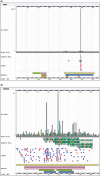COSMIC (the Catalogue of Somatic Mutations in Cancer): a resource to investigate acquired mutations in human cancer
- PMID: 19906727
- PMCID: PMC2808858
- DOI: 10.1093/nar/gkp995
COSMIC (the Catalogue of Somatic Mutations in Cancer): a resource to investigate acquired mutations in human cancer
Abstract
The catalogue of Somatic Mutations in Cancer (COSMIC) (http://www.sanger.ac.uk/cosmic/) is the largest public resource for information on somatically acquired mutations in human cancer and is available freely without restrictions. Currently (v43, August 2009), COSMIC contains details of 1.5-million experiments performed through 13,423 genes in almost 370,000 tumours, describing over 90,000 individual mutations. Data are gathered from two sources, publications in the scientific literature, (v43 contains 7797 curated articles) and the full output of the genome-wide screens from the Cancer Genome Project (CGP) at the Sanger Institute, UK. Most of the world's literature on point mutations in human cancer has now been curated into COSMIC and while this is continually updated, a greater emphasis on curating fusion gene mutations is driving the expansion of this information; over 2700 fusion gene mutations are now described. Whole-genome sequencing screens are now identifying large numbers of genomic rearrangements in cancer and COSMIC is now displaying details of these analyses also. Examination of COSMIC's data is primarily web-driven, focused on providing mutation range and frequency statistics based upon a choice of gene and/or cancer phenotype. Graphical views provide easily interpretable summaries of large quantities of data, and export functions can provide precise details of user-selected data.
Figures



Similar articles
-
COSMIC: mining complete cancer genomes in the Catalogue of Somatic Mutations in Cancer.Nucleic Acids Res. 2011 Jan;39(Database issue):D945-50. doi: 10.1093/nar/gkq929. Epub 2010 Oct 15. Nucleic Acids Res. 2011. PMID: 20952405 Free PMC article.
-
COSMIC: somatic cancer genetics at high-resolution.Nucleic Acids Res. 2017 Jan 4;45(D1):D777-D783. doi: 10.1093/nar/gkw1121. Epub 2016 Nov 28. Nucleic Acids Res. 2017. PMID: 27899578 Free PMC article.
-
COSMIC: the Catalogue Of Somatic Mutations In Cancer.Nucleic Acids Res. 2019 Jan 8;47(D1):D941-D947. doi: 10.1093/nar/gky1015. Nucleic Acids Res. 2019. PMID: 30371878 Free PMC article.
-
Cytogenetic Resources and Information.Methods Mol Biol. 2017;1541:311-331. doi: 10.1007/978-1-4939-6703-2_25. Methods Mol Biol. 2017. PMID: 27910033 Review.
-
MutationView/KMcancerDB: a database for cancer gene mutations.Cancer Sci. 2007 Mar;98(3):259-67. doi: 10.1111/j.1349-7006.2007.00405.x. Epub 2007 Jan 12. Cancer Sci. 2007. PMID: 17233812 Free PMC article. Review.
Cited by
-
Diagnostic and prognostic significance of tetraspanin 6 and its role in facilitating glioma progression.Eur J Med Res. 2024 Oct 29;29(1):522. doi: 10.1186/s40001-024-02119-5. Eur J Med Res. 2024. PMID: 39472973 Free PMC article.
-
The Rho GTPase Rnd1 suppresses mammary tumorigenesis and EMT by restraining Ras-MAPK signalling.Nat Cell Biol. 2015 Jan;17(1):81-94. doi: 10.1038/ncb3082. Epub 2014 Dec 22. Nat Cell Biol. 2015. PMID: 25531777 Free PMC article.
-
Down-regulation of ECRG4, a candidate tumor suppressor gene, in human breast cancer.PLoS One. 2011;6(11):e27656. doi: 10.1371/journal.pone.0027656. Epub 2011 Nov 16. PLoS One. 2011. PMID: 22110708 Free PMC article.
-
PROTACs: Current and Future Potential as a Precision Medicine Strategy to Combat Cancer.Mol Cancer Ther. 2024 Apr 2;23(4):454-463. doi: 10.1158/1535-7163.MCT-23-0747. Mol Cancer Ther. 2024. PMID: 38205881 Free PMC article. Review.
-
The harmonizome: a collection of processed datasets gathered to serve and mine knowledge about genes and proteins.Database (Oxford). 2016 Jul 3;2016:baw100. doi: 10.1093/database/baw100. Print 2016. Database (Oxford). 2016. PMID: 27374120 Free PMC article.
References
-
- den Dunnen JT, Antonarakis SE. Mutation nomenclature extensions and suggestions to describe complex mutations: a discussion. Hum. Mut. 2000;15:7–12. - PubMed
Publication types
MeSH terms
Grants and funding
LinkOut - more resources
Full Text Sources
Other Literature Sources
Medical
Molecular Biology Databases

